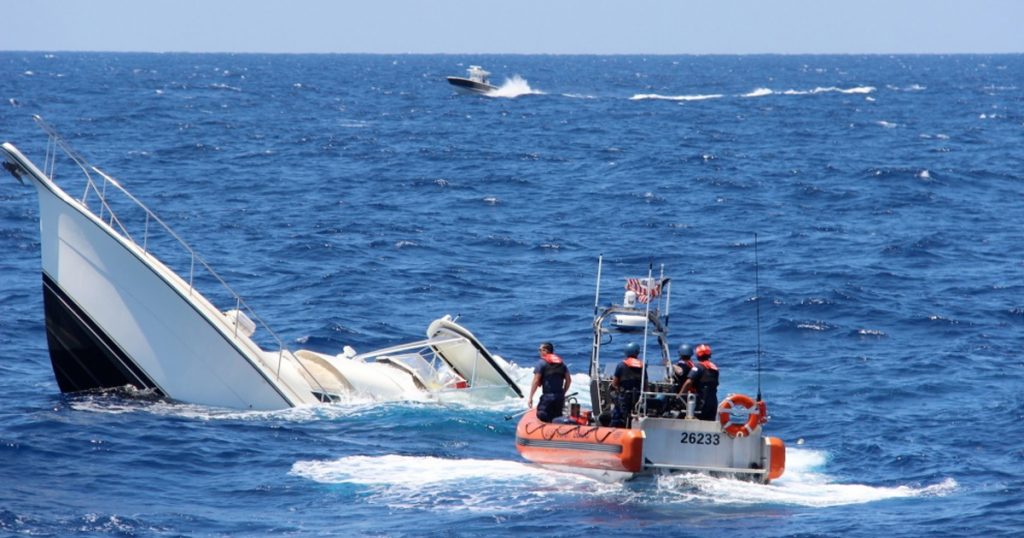By Vincent Pica
Commodore, First District, Southern Region (D1SR)
United States Coast Guard Auxiliary

While four out of five boats sink at the dock (we’ll discuss that next month), I would note that fifth boat – the one that sinks underway – is far more dangerous since you and your crew are aboard and not driving up to the marina to find your mast light sticking up out of your slip… This column is about that.
Why Do Boats Sink at Sea?
Before we get into the other percentages, why’s and wherefore’s, the single most reported reason is water coming aboard from the stern through the out-board engine cut-out. While fine for the bays, be extremely cautious about taking a boat so configured onto the high seas. A following sea can easily “poop” you from behind and overwhelm your capacity to off-load the water.
As to the other percentages and categories, roughly one in five sinkings at sea (18%) are due to direct leaks in the vessel itself, not caused by violent contact with the bottom or the sea itself. Areas of ingress, in order, are:
- Through-hull fittings that give way
- Stuffing box leaks
- Knot-meter plugs
- Bait well discharge back-ups
Roughly one in eight sinkings at sea (12%) are caused by raw (sea) water cooling and exhaust systems failures. These parts, subjected to high heat from engine exhaust gases and the corrosive effects of salt water, simply wear out – and you are now pumping water from the sea into the engine spaces. Hitting something, often rocks, accounts for another 10%. This is called “holing the boat” (i.e., you just put a hole in it.). Roughly one in 20 sinkings at sea (6%) are caused by excess force/excessive speed and the hull comes apart…
What Do I Do Now??
- Put Your Life Jackets On. Right away, direct everyone to don their life jackets. As I have noted before, on my vessel, I have a heavy weather/type-1 life jacket on the back of my helm seat. Across the back, where the crew can read it, it says, “If you see the captain put this on, try to find one for yourself.”
- Don’t Be Bashful. Immediately get on the radio and call the USCG. Tell them where you are, how many people are aboard and where the water is coming from. Why how many people? Because if they get there after the boat goes down, make sure they pick up everybody. No one gets left behind.
- Stop the Leak. If water is coming through a hole in the hull, try to stop it. Jam towels, cushions, extra life jackets – anything – into the hole. Brace the plug with a shoulder only if you have to (you want to avoid having anybody below when the boat sinks). Use a spar, oar, bimini cover pole, boarding ladder – anything – to jam your plug(s) into that hole. An old sailors’ trick is to jam a sail into the hole from the outside. Let the sea pressure work for you. Not a lot of powerboaters carry sails on their Bayliner, but it may give you an idea. You won’t stop the water, but you’ll likely slow it. It’s going to take time for help to arrive, so you have to start doing things to buy yourself more time. Buy time by slowing the ingress of water. You may have to slow down to contain the water pressure on your plug so you are doing a trade-off here – less water but more time to shore. Start with less water and evaluate who’s winning – you or the sea.
- Trim the Boat. If you hit something, it is likely that the hole is in the forward part of the boat and possibly near the water line. Trim the boat up and try to get the hole out of the water. If you can, you win and the sea loses.
- Any Port in a Storm If you are losing the battle after doing everything above, beach the boat if you can. Who cares what happens to the boat at this point? We might be talking about living or dying now. Life first, property last.
- Create a Ditch Bag. If the situation continues to deteriorate, say your prayers but don’t leave the boat until it sinks out from under you. But have a “ditch bag” ready – cell phone, handheld radio, fresh water, dry clothes, medical kit, flash light, flares, etc. – come immediately to mind. It’s always good to have a ditch bag ready whenever you go “outside.” Hit a 45-foot container that fell off a cargo ship on its way from Brazil to Maine, and you won’t have to take your shoes off to count the minutes you have left on your boat.
When you have a leak in your boat, secure the crew, call for help and try to stop the leak. You’re the captain.
If you are interested in being part of the USCG Forces, email me at Vincent.Pica@cgauxnet.us or go direct to the D1SR Human Resources department, who are in charge of new members matters, at d1south.org/StaffPages/DSO-HR.php and we will help you “get in this thing.” ■
Captain Kevin Reed is the Captain of the Port and Sector Commander for U.S. Coast Guard Sector Long Island Sound. CAPT Reed is responsible for all active-duty, reservist and auxiliary Coast Guard personnel within the Sector. As a Commodore of the U.S. Coast Guard Auxiliary First District, Southern Region, Vin Pica works closely with CAPT Reed and his staff to promote boating safety in the waters between Connecticut, Long Island and 200 nautical miles offshore. Sector Long Island Sound Command Center can be reached 24 hours a day at 203-468-4401.




